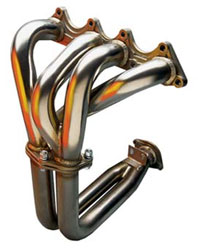 |
An aftermarket set of headers is like a piece of art |
If you read my advice about cold air intakes (hint, hint), you know that the point of most aftermarket engine parts is to increase engine efficiency--to create as much mechanical force as possible from the energy stored within the gasoline in the gas tank. Yeah I know, blah blah blah. In English: the engine has to breathe freely. Aftermarket intakes help the engine inhale plenty of fresh, cold air. Once that air is mixed with fuel and exploded in the engine, it has to go out the exhaust system. Just as with us carbon-based types, smooth exhaling is vitally important to your engine.
A typical stock exhaust system is made up of the exhaust manifold, catalytic converter, muffler, and various lengths of piping to connect them all. The problem with stock exhausts is that they're designed for just about everything except performance: the good folks at the car companies design their exhaust systems to conform to be as quiet, environmentally friendly, and inexpensive as possible. While I'm all for peace and quiet and blue skies and all that, there's nothing I like more than the happy sound of a kickin' exhaust zooming its way down the highway.
When it comes to performance exhaust, we want big pipes with as few restrictions as possible in order to avoid backpressure. Think of blowing hard through a drinking straw versus through a 2" pipe--big difference! Backpressure robs your engine of power because instead of directing energy at the crankshaft, your engine has to push the exhaust out under pressure. The greater the pressure, the greater the power loss. Some backpressure is inevitable, but there's a lot you can do to a stock exhaust system to minimize it. Today, we're gonna take a look at replacing the exhaust manifold with an aftermarket header.
Headers are purely performance-based upgrades. Not only are their pipes bigger than stock, but each cylinder gets its own specially tuned pipe. Tuned pipes? Yep! The lengths, curves, and inside diameters of header pipes are specially designed to follow the rythym of your engine's exhaust valves so that every time a cylinder expels air, an empty header pipe awaits. So, there's very little backpressure for the pistons to work against.
If you've been surfing the web, you've noticed that there are a lot of different exhaust headers for sale. They boil down to two main types--stainless steel and ceramic-coated. Stainless steel headers provide a smooth surface for the quickest possible airflow. They usually are shiny when new, but don't expect that to last! Ceramic-coated headers are usually stainless steel or cast-iron headers that have been coated with a heat-resistant coating that keeps your engine bay a bit cooler. You'll also notice that most headers have a design in which the four exhaust pipes join into two bigger pipes, and then the two join into one final pipe that connects to the rest of your exhaust system. This "4-2-1" design is pretty standard, and most of these headers will be street-legal. Most headers that have a single "4 into 1" collector are designed for full-on racing and are likely not emission-legal.
Installing a header is pretty easy--I'd rate it a 3 out of 10. A couple warnings, though. First, your engine's exhaust runs about 700 degrees Fahrenheit, so make sure you let your engine cool off overnight before poking around the exhaust manifold or header--unless you want to look like Freddy Krueger, that is. Second, as I mentioned above, most headers are street-legal in all 50 states, but be sure to check with the manufacturer just to be sure.
Like the exhaust manifold, the header bolts right up to the engine block using the same bolts. If your exhaust bolts are really rusted, you might want to find replacements for them at an auto parts dealer or hardware store--headers almost never come with their own bolts. While you're at the auto parts store, you should also be sure to pick up a new exhaust gasket.
THE POINT: You can expect to see a gain of about 3 to 4 horsepower right out of the box. Of course, if you replace the full exhaust system, you can expect another 2 to 4 horsepower (not to mention that sweet growl we all love).
Mr. X — Bigger, Better, Faster
|
 - Tech
- Tech
 - Tech
- Tech